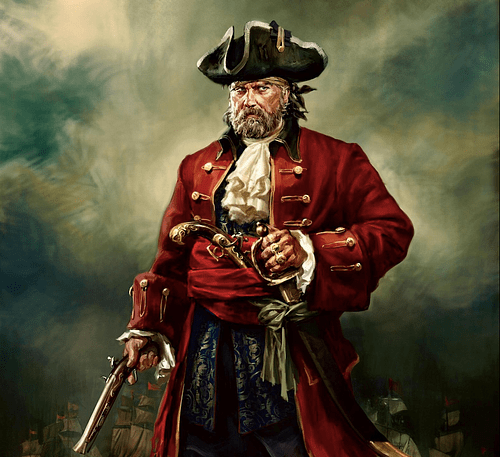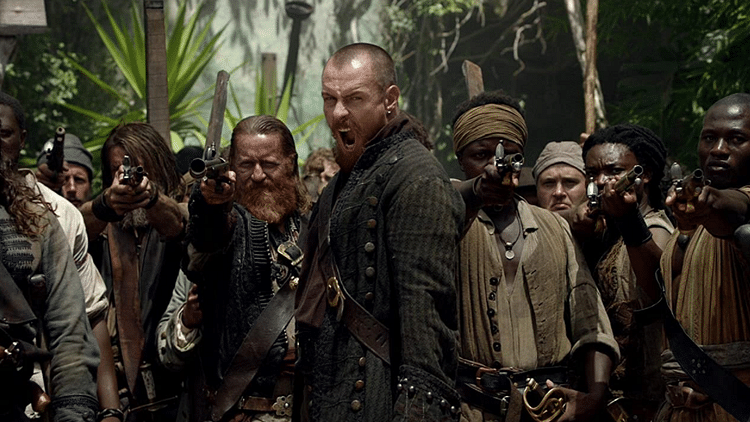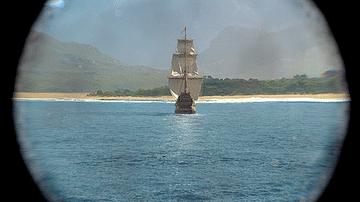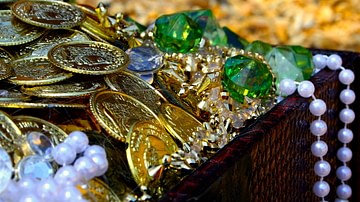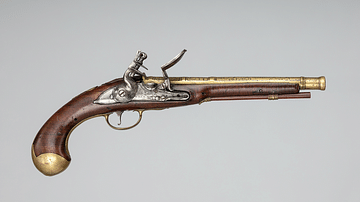Pirates have gained a reputation for wearing bright and distinctive clothing and accessories during the Golden Age of Piracy (1690-1730) even if, in reality, most of what we think they wore comes from works of fiction like Robert Louis Stevenson’s 1883 novel Treasure Island. Pirates were first and foremost seamen and so they wore the clothing typical of all mariners of the period. It is true, though, that some pirates, especially the captains, did dress to impress, and colourful silks or feathered hats were a way to demonstrate success to one’s victims and crew alike.

Materials & Colours
There is no evidence that pirates ever wore clothing particularly different from that worn by other 17-18th century mariners when working on a sailing ship. Life at sea was a tough career, and clothing had to be both hard-wearing and practical. Captains and crew often went for more extravagant clothing when ashore, but the daily clothing of pirate crews was typically that taken from other mariners on captured ships.
The historians A. Konstam and D. Rickman give the following summary of common materials for seamen’s clothing during the Golden Age of Piracy:
Clothes of hard-wearing linen and wool were the most practical for life at sea. From various sources we know that the woollens sailors favoured included broadcloth, noted for the quality of its finish and colour; kersey, good at keeping out wet and cold; shag, a sturdy cloth that was something like a coarse velvet; Welsh plains, resembling flannel; and 'cotton', an inexpensive woollen cloth that got its name from its fuzzy surface. Fabrics made of actual cotton fibre were at that time expensive imports, though fustian, which wove together cotton and linen yarns, was used for cheap clothing. (21)
In terms of colours, blues, tans, dark greens, whites, and greys predominated. Most clothing was plain, but there were also stripes and chequered patterns, too, and a dash of brighter colours like scarlet and yellow could be added to one’s appearance with silk scarves and short sashes.
Coats, Jackets & Shirts
Many pirate captains wore a long coat, typically one taken from a wealthy captive or bought on shore. Captains could afford such items as their share of booty was double that of an ordinary crew member. The fashion on land at the time had men of means wearing coats with an extraordinary array of buttons down the entire length of the front and wide cuffs buttoned back. Bartholomew Roberts (aka 'Black Bart' Roberts, c. 1682-1722) was so famous for a scarlet silk coat and matching damask waistcoat that the French - his principal enemy - called him le jolie rouge ("the pretty red"). Roberts was probably the most successful of all Golden Age pirates, and he showed this fact off by wearing a great gold necklace with a diamond-encrusted cross. Roberts did not just look after himself in the wardrobe department but he also ensured his crew never became too tatty. His ship’s articles, which all Roberts’ crew were obliged to sign when joining up, stipulated that each man received a "shift of cloaths" from each vessel taken.
Ordinary seamen might wear a short jacket, useful for keeping warm, but with no tails to impede agility or get tangled in rigging, etc. These jackets were made of a heavy blue or grey cloth and were known as 'fearnoughts' as they were worn by seamen who climbed the high masts to reef in sails (hence the later name 'reefer jacket'). The cloth was either wool or hard-wearing fustian. A slightly longer jacket might be worn by pirate 'officers', like the quartermaster and boatswain, which ended at the mid-thigh. Buttons for coats and any other type of clothing were typically made of brass, tin, bone, horn, or disks covered in fabric.
In heavy weather, a seaman might prefer a much longer and more waterproof long coat made of canvas. The neck was protected from the wind by a neck scarf, additionally useful in Caribbean waters to mop up sweat. Underneath a jacket or coat, mariners wore linen collarless shirts which were pulled over the head. They also wore sleeved and sleeveless waistcoats, which could be one colour, striped, or chequered.
Trousers
Seamen of all kinds were noted for wearing baggy trousers, often with bell-bottoms since this easily used all of the cloth from a bolt of material like serge. Baggy trousers had the advantage they could be easily rolled up when swabbing the decks, climbing rigging, or wading ashore. There were two infamous female pirates: Anne Bonny and Mary Read (d. 1721), and both wore the trousers and shirts typical of male mariners when in battle. Alternatively, short billowing trousers known as 'petticoat breeches' were worn which could be tied at the knee. Leather pockets were often stitched onto trousers. When in colder regions or seasons, woollen stockings of various lengths were worn.
Headgear
Contrary to almost all depictions in all media, pirate captains are not known to have worn tricorne hats, although it is possible that the more gentrified ones did, like the former privateer Captain Kidd (c. 1645-1701) and the former plantation owner Stede Bonnet (d. 1718). Tricorne hats were certainly fashionable for landlubbers, but the large pointed front brim would have obscured one’s view when it was always necessary to duck under swinging rigging, tackle blocks, and spars on a ship heaving its way across the sea. A hat with three wide points would also have been a great temptation for a moderate wind to carry off over the horizon. Bartholomew Roberts famously wore a feathered hat, while Blackbeard (aka Edward Teach, d. 1718) was known to wear lit fuses under his hat whenever he went into battle.
As part of the attempt to appear more respectable and successful, some captains wore the wigs that were fashionable amongst the rich gentry in the 17th and 18th centuries. Wigs of the period were expensive to make and so the longer they were, the richer one appeared (hence the still used term 'big wig'). Known for their flair and extravagance, a more gentrified pirate captain might decorate his white or black wig with coloured ribbons tied at the ends. Blackbeard did not wear a wig as far as we know, but he did wear black ribbons tied in his great black beard.
Pirates appear wearing colourful bandanas in many illustrations and films, but there is very little evidence they were ever worn. The word bandana comes from the Hindi word bandhnu which refers to a method of dyeing cloth. Ordinary seamen did sometimes wear a scarf tied around the head leaving the crown exposed to act as a sweatband, in which case, the knot was typically tied at the front and not the back of the head.
Seamen of all kinds certainly wore hats, but these were usually reserved for cold weather and were tight-fitting caps made of wool or leather that did not get blown off in high winds. For wet weather, a hat made from canvas might be worn which had been tarred to make it waterproof. A cape of the same material could also be worn in storms. Wet and cold weather clothing ('sloppes') was likely kept as communal ship’s stores and handed out to whoever was above deck and on watch at the time. In warmer weather, the most popular hat for keeping off the sun - at least according to some contemporary descriptions - was a light round hat with a very narrow and circular brim.
Accessories
Pirates are famous for their gold earrings and eyepatches, neither of which were at all common for mariners to wear during the Golden Age of Piracy. Although some have claimed that mariners might have worn an earring as a way to keep a bit of gold aside for future use such as for burial if they happened to die ashore (otherwise they were buried at sea at no cost to anyone), in reality, wearing earrings was regarded as effeminate (Elizabethan courtiers seem to have been the only men daring to sport such trifles, and they were often mocked for doing so). Eyepatches may have been worn by some pirates as injuries were not uncommon on a sailing ship when ropes and tackle could swing about dangerously. Another cause of loss of sight in one eye was because some seamen had to frequently stare at the sun over a sighting stick, an instrument used for navigation. However, in the butch world of piracy, showing one's scars was a way for mariners to demonstrate they had long experience at sea, hence, perhaps, the lack of eyepatches in the historical record.

One accessory that many pirates did wear was something tied across the chest to hold things in. A silk sash could be worn across one shoulder which was useful for keeping pistols in. Small pieces of rope (lanyards) were tied to the sash to keep smaller objects from being lost like a folding knife. Pistols might also be attached to the sash with a cord so that, once fired, they could be dropped quickly but not lost while one resorted to one’s sword or cutlass. Finally, in colder weather, sailors wore knitted gloves or mittens and round-toed leather shoes tied with a small buckle or latchets (laces).
Dressing up for Shore
Although clothing for daily tasks at sea might have been a bit on the dull side, pirates did dress up when they went ashore, for example, to the pirate havens. More extravagant clothes were easily acquired from wealthy passengers aboard captured ships. Certainly, there are records of ordinary pirate seamen wearing extraordinary clothes at their very last public outing: their execution. About-to-be hanged pirates are recorded as wearing fancy velvet coats and jackets, taffeta breeches, gaily-coloured silk shirts, ribboned stockings, fancy-buckled shoes, and felt tricorne hats. Imagine this lot of flamboyant finery with a pistol or two tucked somewhere and a cutlass at the hip, and one has the perfect image of a pirate out and about and ready to paint the town red.
